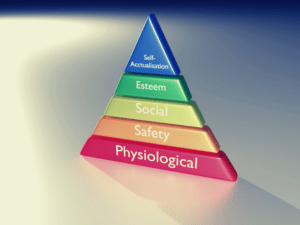Maslow’s Hierarchy of Needs is both an interesting topic and theory. In this article, I will apply the theory of Maslow’s Hierarchy of Needs to the needs of renters. My intended purpose is to provide information to help improve the well-being of your tenants. Surprisingly, this will also increase your income as a real estate investor. At this point, you might be asking why you need to be concerned with your renter’s state of mind. Isn’t that their personal business? Perhaps. However, keeping your renters happy will affect your bottom line. In this article, we will explore how the hierarchy of needs can increase the well-being of your tenants and your bottom line.
WHAT IS MASLOW’S HIERARCHY OF NEEDS?

In 1943, Abraham Maslow presented a paper in Psychological Review entitled, “A Theory of Human Motivation”, which shows the stages of developmental growth in all humans.
This theory is often illustrated in the shape of a pyramid with the most basic human needs, or survival needs, at the bottom. In this image, it is referred to as physiological needs. Those include the following:
- Basics of human necessities such as water, food, clean air, and a place to sleep.
- Safety is the next level which includes things that make humans feel safe such as secure surroundings, physical safety, and good health.
- Social comes next which covers the human needs such as love from others, a sense of belonging, and being part of a family or extended family.
- Esteem affects a human’s self-confidence, ability to achieve goals and respect for and from others.
- At the top of the pyramid is self-actualization. This pertains to a human’s ability to create, pursue endeavors, accept facts, and the ability to take the high road with regard to moral issues.
Some say that the more complex needs are at the top, while the less complex is at the bottom. Although, some disagree with this theory and believe that all are equally complex, each in their own way.
Nonetheless, what’s important to understand is that these needs are sequential. For instance, if someone doesn’t have a clean bed to sleep in safely and comfortably, they aren’t going to be able to accomplish much with their day to day life other than basic survival.
PHYSIOLOGICAL NEEDS
If you’re a single or multi-family property investor, believe it or not, this is something you get to provide for your tenants every day. Sleep is a basic necessity of life, and that’s what you provide – a place where people can sleep. In other words, you meet your renter’s basic needs that include: clean water, a bathroom, a place to eat, and a place to sleep. That also includes electrical, plumbing, and HVAC systems in good working order.
Of course, depending on the area, there are most likely many apartments that meet this level of need, so you need to cover all the levels of the hierarchy of needs to compete with other syndications. So, let’s go on to the next level.
SAFETY AND SECURITY NEEDS
Every tenant expects safety and security to be a part of their living experience, and they depend on you to provide this. Not only do they want their homes to have deadbolt locks, but they also want the surrounding area to be quiet and safe to walk through. Security fences, key cards for safe entry into the amenities, and nightly patrols are a few of these types of security measures that investors provide for their tenants. Others include electrical systems that are in good repair and fire-proofing where appropriate.
This would be incomplete if we didn’t look at the safety and security needs that are being met for you: the investor. As an investor, you get your needs met by your tenants in the way of security of rental income, the security of your investment getting sound returns, and the security that your property continues to perform – ideally, at peak capacity.
SOCIAL NEEDS
Apartments with social amenities are more attractive by far than those without. For this level of the hierarchy of needs, some of those amenities might include a gym, a swimming pool, a dog walk-park, or a meeting room available for use by tenants. Additionally, a back yard is nice, but only if you’re on the street level. For those that live in upper levels, spacious balconies are a nice social amenity to offer.
The cleanliness and the updated maintenance of a building also reflect on the tenants socially as many have family and friends who visit. Naturally, your tenants want to take pride in their surroundings and this is accomplished with regular maintenance that includes: clean sidewalks and stairways, mold-free siding that is regularly refreshed with a new coat of paint, well-maintained landscaping, and plenty of extra parking spaces for guests.
Other social needs include WiFi outlets and cable hookups which are provided by some complexes. However, in others, the tenants install those services separately. These high-tech amenities just might make the difference you need to compete with the complex down the road. Additionally, they are commonplace in today’s world and fast becoming an expected amenity by tenants of all age groups.
ESTEEM BUILDERS
As Maslow’s Hierarchy of Needs theory goes, the first level needs to be accomplished before the second level can be accomplished and so on. If all the factors are in place below this level, it naturally follows that your tenant will feel a good sense of self-esteem when they live in your complex. However, when there are stairways filled with cigarette ashes and no one cleans them, that lowers everyone’s self-esteem. These and other actions that go unchecked, such as garbage strewn around the trash receptacles, only serve to make the landlord look uncaring and it certainly does nothing for their tenant’s esteem.
Esteem builders are when tenants can walk down their stairway without feeling like they’re walking through an ashtray. It’s being able to take their garbage to the designated dumpsters without going through a trashy obstacle course. You can add the largest dumpster available, but if no one on your staff is willing to manage it, it still makes you look bad as a landlord.
So, in short, esteem builders will be the result of the efforts of the landlord to effectively provide each level leading to the result of “esteem” for all tenants.
SELF-ACTUALIZATION
Self-actualization includes the ability to feel great about your surroundings and yourself as an individual. Additionally, it includes all levels leading to this point. When a tenant goes out on their balcony, for instance, what do they see? Do they see mountains or groves of trees in the background? Is your complex surrounded by enough greenery to give a feeling of community within the complex? Are there enough amenities in good repair that make life comfortable for your tenants?
Are tenants who work from home able to do so without lots of loud noises interrupting their work? Moreover, are your tenants able to relax and enjoy life without hearing the screaming laughter of neighboring children left unattended? I’m sure you could come up with a long list of actions that can bring about low morale. Indeed, it is landlord management that brings about the good results of self-actualization.
GENERATIONAL EXPECTATIONS
Different generations expect different things from the rapid technological growth that has occurred over the last 50 years. It goes without saying that the younger the tenant, the more technologically demanding they are. Rightfully so, as they were born into a world where electronic devices and being connected are a normal way of life. I would venture to say that they include a large number of their population that don’t remember what a “landline” is – much less how to use them.
Contrarily, older generations are not as technologically adamant as the Millennial or Gen Z population but may have other technological needs, such as electric wheelchair lifts, automated medical monitoring, and automated emergency responder notification.
GENERATIONAL EXPECTATIONS
Different generations expect different things from the rapid technological growth that has occurred over the last 50 years. It goes without saying that the younger the tenant, the more technologically demanding they are. Rightfully so, as they were born into a world where electronic devices and being connected are a normal way of life. I would venture to say that they include a large number of their population that don’t remember what a “landline” is – much less how to use them.
Contrarily, older generations are not as technologically adamant as the Millennial or Gen Z population but may have other technological needs, such as electric wheelchair lifts, automated medical monitoring, and automated emergency responder notification.
• AN AGING POPULATION
There are specific expectations to the hierarchy of needs that change as people grow older. For instance, retired seniors usually prefer golfing amenities in addition to playgrounds for their visiting grandchildren. Conversely, a Millennial will most likely be content with larger playgrounds, picnic areas, and swimming pools for more youthful oriented activities.
In addition, with age comes the necessity of easier access. That might include a single level dwelling vs. a multi-level. If senior housing is multi-level, there needs to be an elevator available. Additionally, older generations expect easier access to bathtub and showers and look for safety features such as guardrails and ramps for ADA compliance.
Easy access to public transportation, shopping, and entertainment is also an expectation of this generation. Moreover, they tend to lean towards housing that includes socially active community centers that allow them to get to know their neighbors.
WHAT THE MILLENNIAL WANTS
The hierarchy of needs for the Millennial is changing the landscape of apartment dwelling. The world has changed; unfortunately, many apartment complexes have not kept up. Rapid change is not going to slow down so it’s time for landlords to ramp up their game if they want to cash in on the huge market of millennial tenants. Here is a list of some of the hierarchy of needs expected by a millennial in their day-to-day normal activities.
- High-speed, dependable internet access.
- Do you know that over 70 percent of the Millennial have pets? Put pet-friendly on that amenities list.
- Smart home automation. This includes appliances, security, and HVAC.
- Electrical outlets that include USB charging outlets. This should be standard in new buildings and is easy to add to the older complexes.
- Green features such as solar panels on the rooftops or efficient recycling bins availability.
- Amenities that are free to renters such as gyms or work-out rooms, clubhouses or meeting spaces, and even movie screening rooms.
- Because most of the Millennial age group likes to live alone, they expect good security in the way of safe neighborhoods with low crime rates, updated security systems, deadbolts, secure windows, and well-lit entrances.
- Living in a central location is key to this generation. They want to be close to work, shopping and play. That means close proximity to businesses, stores, and nightclubs.

